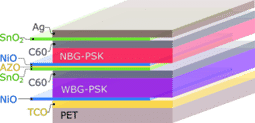The photovoltaic market and us have a long history. Spatial Atomic Layer Deposition (Spatial ALD) has been widely adopted for the production of an ultra- thin surface passivation layer on silicon PERC solar cells. Our experience and technology makes it possible to produce high-quality, high-efficiency solar panels with atomic level precision that requires less raw materials. In other words; do more with less! Besides interface passivation by a few nm’s of aluminium oxide we have recently investigated the passivation performance of hafnium oxide in silicon solar cells. Those results have been published in a collaboration with ISFH, you can find them under the “Our Research” page! Spatial ALD also offers many opportunities in upcoming solar cell markets such as organic, perovskite, and silicon-perovskite tandem photovoltaics (PV). Although perovskite solar cells (PSC’s) have already reached the same performance as their silicon counterparts, the stability and sensitivity to water have hindered perovskites from large scale market introduction. Ultra-thin charge transport and surface passivation layers synthesized with Spatial ALD have shown to significantly improve the performance and stability of perovskite solar cells. To maximize the stability and power output of the perovskite absorber layer the inter-layers play a pivotal role and should be conformal and pinhole free. A few examples, Spatial ALD of tin oxide (SnO2) can act as an electron transport (or buffer) layer and has already been proven effective in pilot production of PSC’s. Thin nickel oxide (NiO) is an emerging hole transport layer which has been uniformly deposited by spatial ALD on M20 wafers even at temperatures as low as 80°C. Aluminium oxide (Al2O3) passivation and migration layers of less than 1 nm can significantly extend the life time of the PSC. Direct encapsulation of the perovskite device by ultrathin aluminium oxide can significantly improve the moisture barrier performance and thus the perovskite stability, see S2R results. Together with the very high deposition rates >5 nm/s the manufacturing costs can be substantially minimised. Hence, organic and perovskite solar cells provide the opportunity for flexible and light weight applications required for building integrated photovoltaics (BIPV) and the Internet of Things (IoT). For the commercial breakthrough of perovskite solar cell technology high density (barrier-like) metal oxide inter-layers, processed by Spatial ALD, will ensure higher stability and longer device lifetime. In parallel, Spatial ALD can be used to apply a moisture and oxygen barrier as a direct and side encapsulation solution. The moisture barriers can also be deposited on PET or PC as a replacement for the present pricey laminated barrier foils. We are currently taking part in several EU projects such as NEXUS, TRIUMPH and SuPerTandem with renowned research institutions, universities as well as leading European companies in the field of perovskite R&D. The flexibility of Spatial ALD enables customisation, allowing manufacturers to develop solar cells with different structures and properties depending on the specific application. Please challenge our innovators; together we will develop your Spatial ALD application to the next level. Advancing Solar Technology with Spatial Atomic Layer Deposition
SALD Markets
Advancing Solar Technology with Spatial Atomic Layer Deposition
Thin film technologies
Customised solutions with Spatial ALD
The differences
Temporal ALD vs Spatial ALD
Temporal ALD
Spatial ALD
Innovation by working together
Get in touch!
Are you ready to explore new opportunities together? We are!
Discover the opportunities that Spatial ALD offers for your sector or project. Are you ready to explore the future of battery technology? Get in touch.


